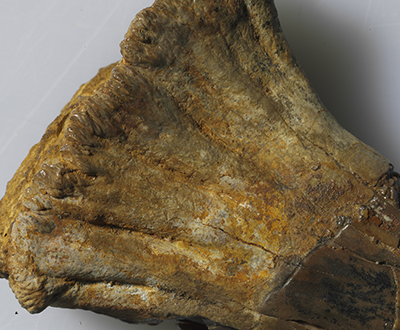April 2024: Rostral tooth of a Cretaceous sawfish
Onchopristis numidus (Haug, 1905)
SNSB-BSPG 1912 V 501
Onchopristis numidus (Haug, 1905)
Upper Cretaceous, Lower Cenomanian
~ 95 million years
Bahariya, Egypt
During the Cretaceous, large parts of what is today’s North Africa were covered by a shallow sea. At this time, extensive river deltas stretched into areas that are now characterized by deserts. A common inhabitant of these river deltas was Onchopristis numidus, whose fossils can be found today throughout North Africa, from Morocco to Algeria and Libya to Egypt. Most of these fossils are rostral teeth, like the one exhibited here.
Onchopristis, like today’s sawfish, had an elongated rostrum that was covered with “teeth” on both sides. These so-called rostral teeth are not true teeth, but are formed from modified scales. In Onchopristis, these rostral teeth were additionally equipped with one or two barbs. The actual teeth in the mouth of Onchopristiswere relatively small in comparison and strongly curved back.
In modern sawfish, the long snout fulfills important functions in both tracking and killing prey. Sensitive electroreceptors along the snout can sense weak electric fields emitted by all living animals. Once the prey has been detected, the sawfish uses its long toothed snout to strike at the prey or push it to the ground.
Onchopristis reached an impressive size of up to nine meters. The animal’s snout alone could grow up to two meters long. Despite this impressive size, even adult Onchopristis were not safe from some predators. In addition to over ten meters long crocodiles, such as Aegisuchus, danger also lurked on the banks of the rivers. In 2005, the snout of a giant spinosaur was found. One of the tooth sockets of the giant predatory dinosaur still contained a vertebra of Onchopristis, which had become wedged between the bone and the tooth of the predatory dinosaur. This fossil thus provided direct evidence that Onchopristis was on the menu of these giant predatory dinosaurs.

Onchopristis reached an impressive size of up to nine meters. The animal’s snout alone could grow up to two meters long. Despite this impressive size, even adult Onchopristis were not safe from some predators. In addition to over ten meters long crocodiles, such as Aegisuchus, danger also lurked on the banks of the rivers. In 2005, the snout of a giant spinosaur was found. One of the tooth sockets of the giant predatory dinosaur still contained a vertebra of Onchopristis, which had become wedged between the bone and the tooth of the predatory dinosaur. This fossil thus provided direct evidence that Onchopristis was on the menu of these giant predatory dinosaurs.
Max Kellermann, München



